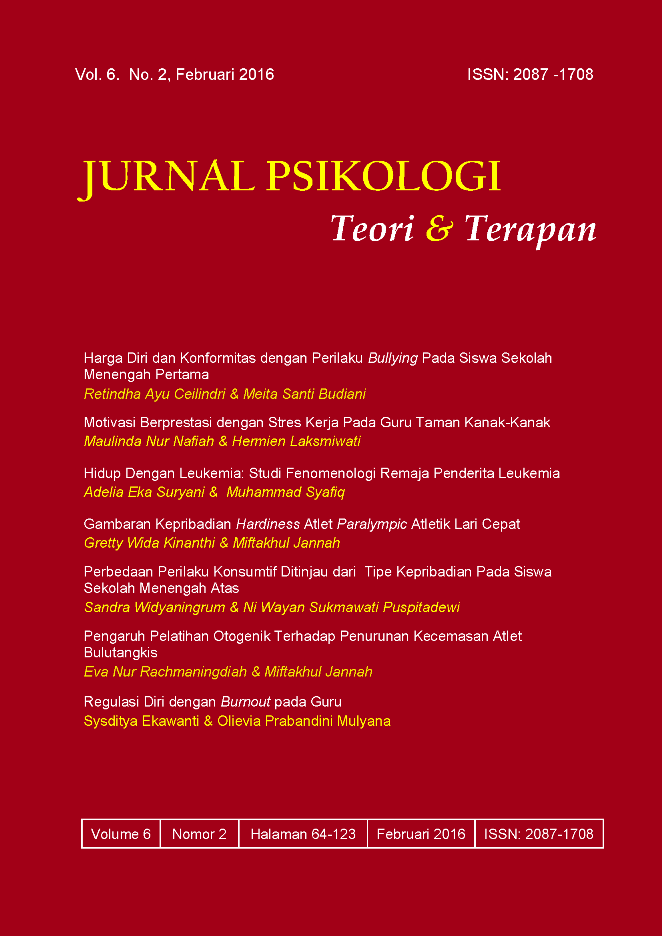Regulasi Diri dengan Burnout pada Guru
DOI:
https://doi.org/10.26740/jptt.v6n2.p113-118Keywords:
regulasi diri, burnout, guruAbstract
Teachers begin to experience symptoms of fatigue due to heavy workload characterized by working ineffectively in the classroom so that the interest of the students declined. This study aims to test whether there is relationship between self-regulation and burnout in teachers. The population was junior high schools teacher. This study use population research, where all the population used as a sample. Researchers use all certified teachers in the school, participants are 35 teachers. The approach used is quantitative method. Data collected using self-regulation and burnout scales, and analyzed using pearson product moment correlation test. The results obtained from this study indicate that there is a significant relationship between self-regulation with burnout in teachers. Significant relationships are seen from the p-value of 0.017 and r value of -0.401. The r value indicates that the relationship between the two variables have a negative direction, meaning that the higher of self-regulation, the lower of burnout. Individuals good self-regulation be able to cope stress and emotions, because of burnout arising drag on stress experienced by the individual.
Abstrak: Guru mulai mengalami gejala kelelahan akibat beban kerja yang berat yang ditandai dengan kurang bekerja efektif didalam kelas sehingga minat kepada peserta didik menurun. Penelitian ini bertujuan untuk menguji apakah ada hubungan antara regulasi diri dengan burnout pada guru. Populasi penelitian ini adalah guru SMP. Penelitian ini menggunakan penelitian populasi, dimana semua populasi digunakan sebagai sampel penelitian. Peneliti menggunakan semua guru yang sudah sertifikasi di sekolah tersebut yang berjumlah 35 orang guru. Pendekatan yang digunakan ialah kuantitatif. Data dikumpulkan menggunakan skala regulasi diri dan burnout, dan dianalisis menggunakan uji korelasional pearson product moment. Hasil yang diperoleh dari penelitian ini menunjukkan bahwa terdapat hubungan yang signifikan antara regulasi diri dengan burnout pada guru. Hubungan yang signifikan tersebut dilihat dari nilai p sebesar 0,017 dan nilai r sebesar -0,401. Nilai r tersebut menunjukkan bahwa hubungan kedua variabel memiliki arah negatif, artinya semakin tinggi regulasi diri maka semakin rendah burnout. Regulasi diri yang baik yang dimiliki individu akan mampu mengatasi stres dan emosi dalam dirinya, karena burnout timbul akibat stres yang berkepanjangan yang dialami individu.
References
Asizah & Hendarti, F. (2013). Intensitas Komunikasi Antara Anak Dengan Orang Tua dan Self Regulation pada Remaja Pesantren. Jurnal Psikologi Indonesia. 2 (2): 99-107. Surabaya: Universitas 17 Agustus.
Faturrahman. (2012). Pengantar Pendidikan. Jakarta: Prestasi Pustaka Publisher.
Landeche, P. (2009). The Correlation Between Creativity and Burnout in Public School Classroom Teachers. Tesis. University of Southwest Lousiana. Online. http://etd.lsu.edu/. Diakses 19 Oktober 2014.
Maslach, C., & Jackson, S. E. (1981). The measurement of experienced burnout: summary. Journal of Occupational Behavior, 2 (2), Online. http://online library.wiley.com. Diakses 19 Oktober 2014.
Maslach, C., Schaufeli, W. B., & Leiter, M. P. (2001). Job Burnout, Annual Review of Psychology. 52 (1), Online. http://www.annualreviews.org/. Diakses 19 Oktober 2014.
Mondy, R. W. (2008). Manajemen Sumber Daya Manusia. Jilid Kedua, Edisi Kesepuluh. (Alih Bahasa: Bayu Airlangga). Erlangga.
Pintrinch, P. R., & De Groot, E. V. (1990). Motivational and Self-Regulated Learning Components of Classroom Academica Performance. Journal of Educational Psychology. 82 (1), Online. http://web.stanford.edu/. Diakses 19 Oktober 2014.
Prasad, S., Lim, V. K. G., & Chen, D. J. Q. (2010). Self-Regulation, Individual Characteristics and Cyberloafing. PACIS Proceedings. Paper 152.
Sihotang, I. N. (2004). Burnout Pada Karyawan Ditinjau dari Persepsi Terhadap Lingkungan Kerja Psikologis dan Jenis Kelamin. Jurnal Psikologi, 1 (1), Online. http://fahrudin.weebly.com/. Diakses 19 Oktober 2014.
Taylor, S. E., Peplau, L. A., & Sears, D. O. (2009). Psikologi Sosial. Jilid Pertama, Edisi Kedua Belas. (Alih Bahasa: Tri Wibowo). Jakarta: Kencana Prenada Media Group.
Zimmerman, B. J. (1989). A Social Cognitive View of Self-Regulated Academic Learning. Journal of Educational Psychology, 81 (3), Online. http://www. researchgate.net/. Diakses 19 Oktober 2014.
Zimmerman, B. J. (1998). Academic Studying and the Development of Personal Skill: A Self-Regulatory Perspective. Journal of Educational Psychology¬, 33 (2/3), Online. http://www2.sunysuffolk.edu/. Diakses 19 Oktober 2014.
Zimmerman, B. J.. (2000). Self-Efficacy: An Essential Motive to Learn. Journal of Contemporary Educational Psychology. 25, Online. http://www.itari.in/. Diakses 19 Oktober 2014.
Zimmerman, B. J.. (2002). Becoming Self-Regulated Learner: An Overview. Theory into Practice, 41 (2), Online. http://www.tandfonline.com/. Diakses 19 Oktober 2014.
Zimmerman, B. J. (2008). Investigating Self-Regulation and Motivation: Historical Background, Methodological Developments and Future Prospects. American Educational Research Journal, 45 (1), Online. http://aer.sagepub.com/. Diakses 19 Oktober 2014.
Zimmerman, B.J., & Schunk, D. H. (1994). Self-Regulation of Learning and Performance: Issues and Educational Applications. America:
Lawrence Erlbaum Associates Inc. Online. https://books. google. co.id/. Diakses 19 Oktober 2014.
Downloads
Published
How to Cite
Issue
Section
License
Authors who publish in this journal agree to the following terms:
Copyright in any article is held by the author.
The author grants the journal, publication rights with the work simultaneously licensed under a Creative Commons Attribution License that allows others to share the work with an acknowledgment of the work's authorship and initial publication in this journal.
Authors may enter into separate, additional contractual arrangements for the non-exclusive distribution of the journal's published version of the work (e.g., posting it to an institutional repository or publishing it in a book), with an acknowledgment of its initial publication in this journal.
Authors are permitted and encouraged to post their work online (e.g., in an institutional repository or on their website) prior to and during the submission process, as this can lead to productive exchanges, as well as earlier and greater citation of published work.
 Abstract views: 4145
,
Abstract views: 4145
, PDF Downloads: 4480
PDF Downloads: 4480


















